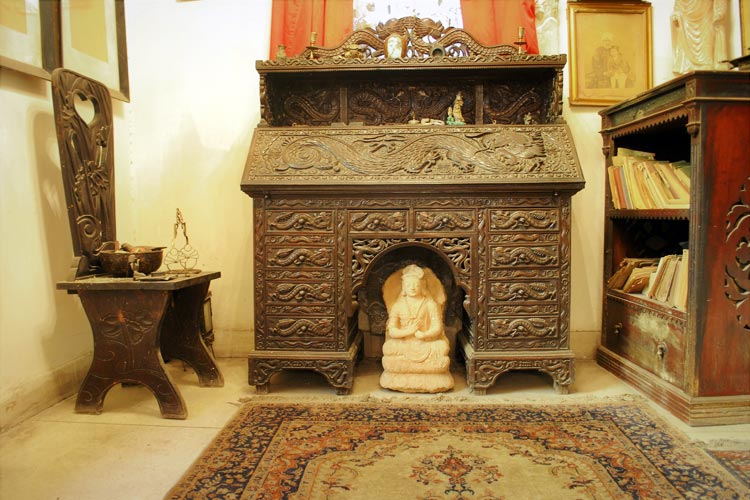The Treasure of Faqir Khana
By Aown Ali
Youlinmagazine : October 23, 2017
Faqir Khana Museum, the first ever private museum in Pakistan was established in 1937
Tucked away in Bazar-e-Hakeeman, a bustling street inside Bhatti Gate, Faqir Khana is the ancestral Haveli of Faqir Syed, an eminent family of Lahore belonging to the Bukhari clan. The reign of Maharaja Ranjit Singh was the culmination of their influence, when three Faqir Syed brothers were the chief courtiers of the Maharaja. Faqir Syed Azizuddin was the key spokesperson and trusted negotiator of the Maharaja. He led the darbar in all dealings with the state’s neighbors, including the increasingly powerful British in India. Faqir Syed Imamuddin held the keys to Govindgarh Fort, where the Sikh treasury and armory were located. Faqir Nuruddin occupied a position of prominence at the court, and after Ranjit Singh’s death in 1839, he acted as a member of the regency council during the minority of the young Maharaja Duleep Singh. The Resourceful Fakirs by F.S. Aijazuddin, is a fascinating study of these three influential characters.
The difference between Sikh and Hindu practices are obvious and well documented over the past 140 years. Following the annexation of Punjab and loss of royal patronage, the number of Sikhs started to decline rapidly. Sikhs were reverting back to Hindu practices and if a generation had become non Keshdhari then they would start using 'Kumar' instead of Singh and by the next generation they identified themselves as Hindus. This was particularly true for non Jatt community. The Singh Sabha Movement came in the 1870s, and the Lahore branch did a tremendous work in eradicating the non-Sikh practices based on Gurbani.
Faqir Khana is the ancestral haveli of Faqir Syed family in Bhatti Gate, Lahore
Faqir Khana Museum was established in 1937, when Faqir Syed Jalaluddin enlisted the entire collection of his family, and declared it a trust. It was the first ever private museum in Pakistan, with a very good collection of miniature paintings, manuscripts, calligraphies, carpets, rugs, wood carving, ivory artifacts, metal wares and personal souvenirs of the family. The 68 page list of the collection made by Faqir Jalaluddin contains details of 811 relics, 18 manuscripts, 557 miniature paintings and ivory artifacts, five statues of Gandhara Art, 172 pieces of porcelain and metallic crockery, 11 rugs, 30 letters and certificates of appreciation, and a number of armory, furniture and other objects.
Gandhara Art at Faqir Khana Museum
About half a kilometer inside the Bhatti Gate, we come across the grand wooden gate of Faqir Khana or the mansion of Faqir Syed family. It’s a 19th century building of amazing Indian Haveli Architecture. Faqir Syed Saifuddin is the curator of this unique and remarkable collection, which is open to visitors, without any ticket or unnecessary restrictions.
Faqir Syed Saifuddin sits in the first hall of the Museum on the ground floor. The wall behind him is adorned with a variety of armor from the Sikh period; other walls of this room display some antique carpets, made in Lahore during the period of Mughal Emperor Shah Jahan (1592-1666).The galleries of the museum are located on the third floor. In the western rim of the Faqir Khana mansion, at least three halls and a corridor are reserved for the Museum. The first hall houses miniature paintings, art pieces made of ivory, carved furniture, souvenirs of Faqir Syed family, a few busts and Chinese porcelain vases, including a framed image of Maryam Zamani, the Armenian wife of Emperor Akbar. The woman in the painting is in European attire, with the caption, “Image of Maryam Zamani spouse of King Jalal Uddin Muhammad Akbar.”
The next hall displays some artifacts of Gandhara Civilization, but the main collection in this section is the unique Chinese and Japanese crockery with a wonderful piece, a wooden kettle that has Chinese characters carved on it.
Maryam Zamani, the Armenian wife of Emperor Akbar
The next portion of the museum consists of manuscripts, the prize of Faqir family collection. Syed Saifuddin, the curator, tells the story: “Faqir Syed Ghulam Muhyuddin, father of the three resourceful courtiers of Ranjit Singh, was in the publishing business. For that purpose, he traveled far and wide in the Indian Subcontinent to collect the best works. Due to his dedication, Faqir Syeds had a collection of almost 10,000 books by 1790,” and Saifuddin regards these books and manuscripts as the foundation for this precious collection.
A Chinese wooden kettle
According to Syed Saifuddin, the family has a great collection of Islamic relics and calligraphy, including the personal belongings of the Prophet of Islam Hazrat Muhammad (P.B.U.H) and his family. There are also some unique works by the great Islamic calligraphers Yaqut al Musta'simi, and Abdul Rashid Dlemi. According to Syed Saifuddin, these relics are known as the Timurid Collection, which Amir Timur obtained from the Ottoman Sultan Bayezid Yildirim in around 1400s. After changing many hands, the sacred relics came to Ranjit Singh in 1806, but were put under the care of the Faqir brothers, and after the death of Ranjit Singh in 1839, under the custody of Faqir Syed Nuruddin. A part of this collection is displayed in the Badshahi Mosque, Lahore, and the rest is under the guardianship of the Faqir Syed family, who display it once a year in Muharram.
Faqir Syed Saifuddin, the curator of this collection
The care and organization with which the Faqir Khana Museum is run, should be an example that other state run museums in Pakistan should strive to emulate.





